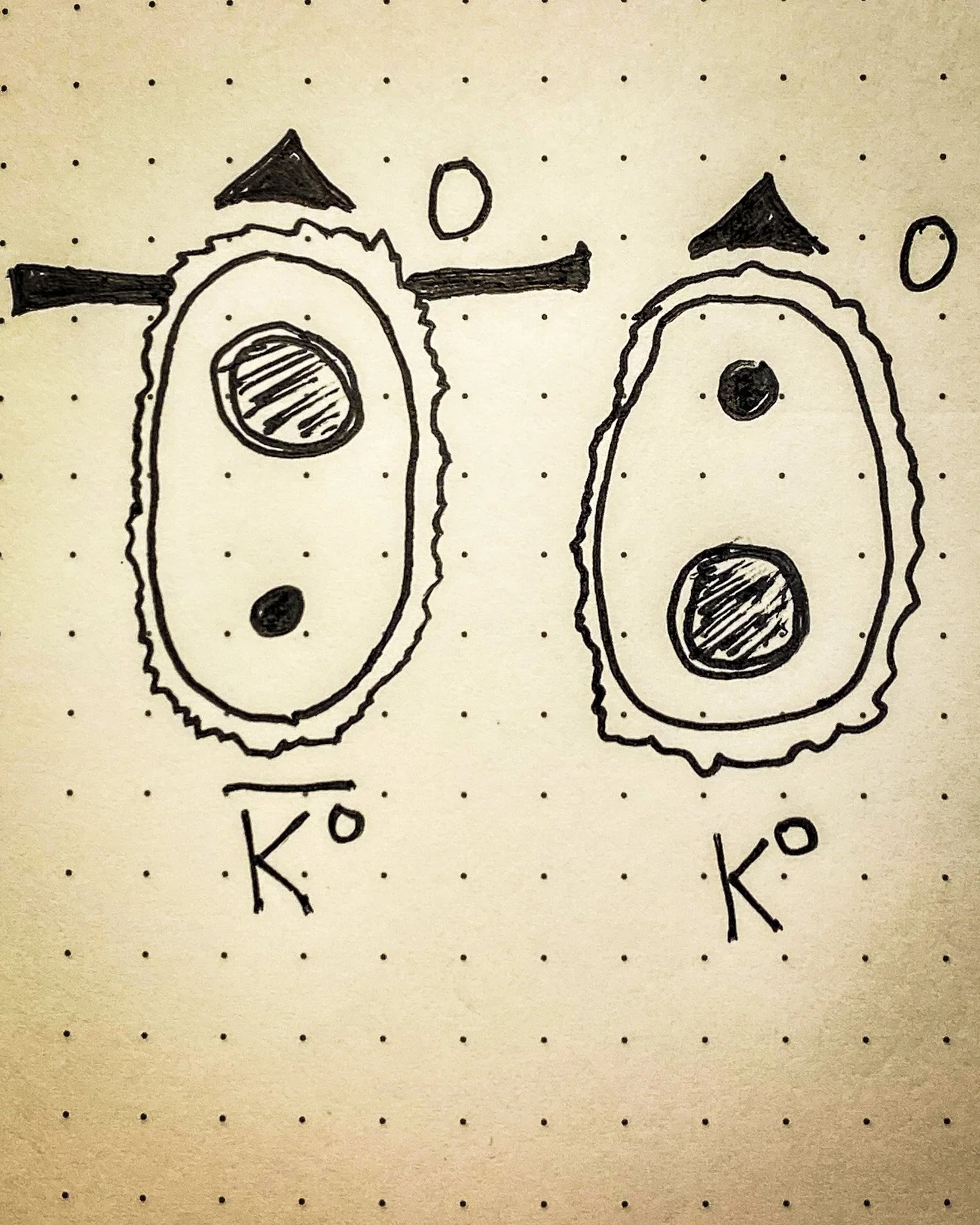
The Neutral Kaons
Before we can describe neutral kaons in the wild, we need to take a quick detour to the city.Mixing Directions
South of downtown Seattle resides the historic Pioneer Square. Bricks line the sidewalks and the ends of metal, reinforcement bars stick out of the old, stone buildings. Approaching the iconic Smith Tower, you cross Yesler Way, and something happens. The direction of the streets change.South of Yesler, the streets all run North to South. The grid, in other words, matches the cardinal points of the compass: North, South, East and West. When you cross Yesler, confusingly, this grid rotates by 45 degrees.
The streets of downtown Seattle - between Yesler Way and Denny Way - all point Northwest or Northeast. The rotation of streets is made to match the contour of Elliot Bay. Streets run either parallel or perpendicular to it.
This idea of a 45-degree shift in our frame of reference, mixing North with West or North with East, is very similar to how the neutral Kaons behave in the wild.
The Neutral Kaons
There are two, electrically neutral kaons. K0 and K0(bar), like the η and η′ mesons - which are also electrically neutral - these neutral kaons are mesons that include a strange quark.The strange quark is like the down quark, only quite a bit heavier. Because it’s heavier, the particles comprised of them like the kaons, also tend to be a little bit heavier.
Mesons - like the kaons - are quark molecules made from one quark and one antiquark.
The strange quark is a heavy version of the down quark, and so both have an electric charge of −1/3. Neutral kaons are combinations of to quark-antiquark pairs: down-antiStrange and strange-antiDown. These two combinations are called K0 and K0(bar), respectively.
With masses just shy of 500 MeV, these neutral kaons are heavy. Unlike the heavy and short-lived η and η′ mesons, the lifetime of these neutral kaons is considerably longer. Like the Λ0 baryon, the strange quark makes it difficult for the neutral kaons to decay.
How they decay brings us back to the streets of Seattle.
The Long and Short of It
The charged kaons presented a mystery because they could decay to both three pions and two pions. This confused particle physicists for quite some time.Neutral kaons also share this curious property, with their own nuance.
Like the street map of Seattle, K0 and K0(bar) mix. While moving through space, a K0 can spontaneously change into a K0(bar) and vice versa. This mixing is something of an artifact of an even stranger phenomena.
Strictly speaking, neither K0 nor K0(bar) interacts with Weak nuclear force. Only mixtures of them are allowed to interact the W bosons. Just like North and East can combine to Northwest and Northeast, we think of these kaon combinations as K0+K0(bar) or K0−K0(bar). It’s like a rotation by plus or minus 45 degrees.
How is the possible? In a word, Quantum Mechanics. You might say that the Strong nuclear force - the thing that binds quarks together into bigger particles - respects the individual identities of those quarks: up, down and strange. The Weak nuclear force, however, does not. These particle-antiparticle oscillations are similar to the flavor oscillations experienced by the three flavors of neutrini.
The “minus” combination is sometimes called K-short, because it decays relatively quickly: just shy of 8 percent of a nanosecond. The “plus” combination is sometimes called K-long, which takes 50 nanoseconds.
Any nanoseconds is an eternity by particle physics standards, but it’s remarkable that K-short decays 1700 times faster than K-long given that they’re made of the same things.
In some sense the K0/K0(bar) mixing occurs because the K-short combination wants to decay so much faster than K-long. Given a beam full of only K0 particles, it will eventually turn into only a beam of K-long particles in short order. Those K-shorts will all decay.
The K-short itself decays into pairs of pions, either two π0 or a π+ and π- pair.
K-long decays into three pions: either one of each pion or three π0’s. The K-long actually decays into electrons or muons too - or their associated antiparticles - along with a single charged pion of opposite charge.
In Summary
The number of fine details in the mixing of neutral kaons is staggering. I’ll give you three examples. First: if a K0 decays into an electron-like particle, it’s virtually always going to be the antielectron - a positron - with a π-. Second, and oppositely, if K0(bar) decays like that, it will always output an electron with a π+. Finally, there is an extremely small mass difference between K-long and K-short. 3 parts per trillion.The quantum mixing of the two neutral kaons is just the first hint that particle physics only gets more complex and strange as we delve deeper into it. So take a breath. Relax your shoulders. And then get excited. There’s still plenty more to see.